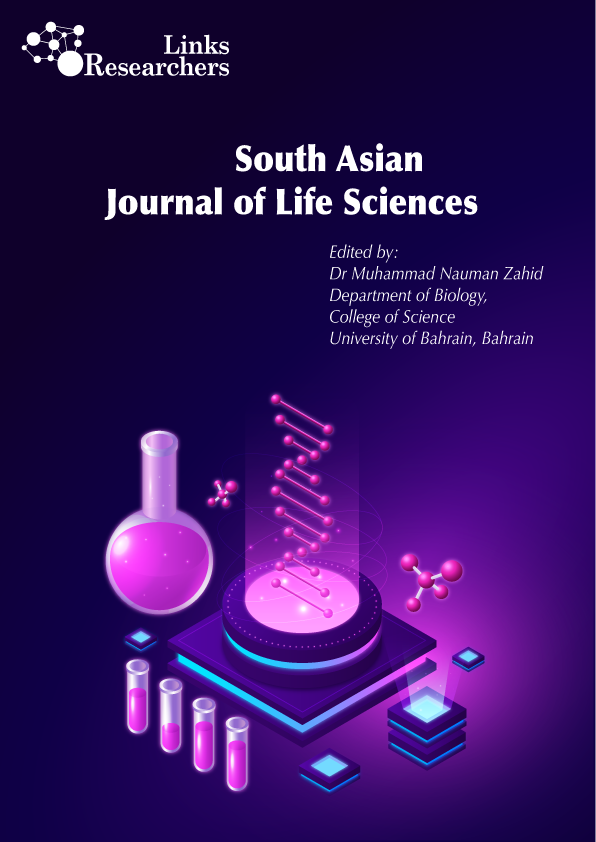South Asian Journal of Life Sciences
Short Communication
South Asian Journal of Life Sciences 1 (1): 1 – 4General Perspective Regarding Hand Washing Practices in Karachi, Pakistan
Sikandar Khan Sherwani1*, Kanwal Nazim2, Akhtar Amin Memon3, Tanveer Hussain4, Haroon Ahmad5, Mirza Tasawer Baig6, Shahana Urooj Kazmi7
- Department of Microbiology, Federal Urdu University of Arts, Science and Technology, Karachi–Pakistan
- Marine Reference Collections and Resource Centre (MRCC), University of Karachi, Karachi–Pakistan
- Dow Medical College Karachi–Pakistan
- Institute of Bioinformatics and Biotechnology, University of Veterinary and Animal Sciences, Lahore
- Centre of Biotechnology and Microbiology (COBAM), University of Peshawar
- Faculty of Pharmacy, Federal Urdu University of Arts, Science and Technology–Karachi–Pakistan
- Department of Microbiology–University of Karachi
*Corresponding author:[email protected]
ARTICLE CITATION:
Sherwani SK, Nazim K, Memon AA, Hussain T, Ahmad H, Baig MT and Kazmi SU(2013). General perspective regarding hand washing practices in karachi–pakistan. South Asian J. Life Sci. (1): 1 – 4.
Received: 201 3–07–16, Revised: 2013–08–02, Accepted: 2013–08–03
The electronic version of this article is the complete one and can be found online at
(
http://nexusacademicpublishers.com/table_contents_detail/25/89/html
)
which permits unrestricted use, distribution, and reproduction in any medium, provided the original work is properly cited
ABSTRACT
This survey was conducted to evaluate the hand washing practices in the cosmopolitan city of Karachi–Pakistan. In this study, male (n = 250) and female (n = 200), between the age group 20–50 years, were asked regarding their hand washing attitude and their perception. All the respondents were literate with minimum school level and maximum higher education (university graduate). Despite the fact washing is a part and parcel being religious instruction of Islam, and Karachi is considered as the most advanced, cultured and educated city, the results of this survey were not up to expectation. Only 30% were aware of the fact that the contaminated hands may spread diarrhea, other practices like coughing and sneezing may contribute in spreading infections in the community was known to 40% only. Apart from this, only 40% reported to wash hands frequently, about 50% knew about antibacterial soap, 40% yet wash hands with plain water without soap, nonetheless, most of the respondents like 80% often get confused in the selection of antibacterial soap due to multitude number of commercial claiming themselves the best. Moreover, majority of the respondents 60% use towel for drying hands and among them, 70% of the population shared towel at home and other places. Furthermore, 50% follow the culture of washing hands before having food and 70% follow good practice as wash hands after using toilet. In addition to this, 80% were cognizant of this fact that the training in terms of course curricula must be introduced at grass root level in schools.
The involvement of hands in the transmission of infections has been well accepted in literature. However, the compliance to hand washing is exceedingly low. Many reasons account for this, including lack of hand decontamination facilities; less availability of time due to high number of patients and inadequate knowledge regarding the proper methods of decontamination as well as the risks of non–compliance. Hand hygiene esp. in healthcare settings is strongly recommended by the United States CDC; and is considered to be highly important way to prevent the transmission of pathogenic bugs. Washing hands using soap and water is the most efficient method to decrease the number of microorganism on them. However, in case of unavailability, 60% alcohol containing sanitizers are also considered useful, although sanitizers do not remove all kinds of germs. Globally, many studies have shown the contamination of hands and resulting transmissions of various kinds of microbial pathogens. A study reported hands of 17% of the staff of an intensive care ward to be contaminated with Klebsiella spp [2]. It also showed that routinely washing of hands significantly reduced the frequency of patients infected with Klebsiella spp . Gwaltney et al reported a 71% transmission of Rhinovirus within only 10–second hand contact exposures. A study from Iowa City, USA reported an epidemic of infection with Pseudomonas aeruginosa in surgical ICU through the hands of a health care providers.Lues et al proved a very significant 98% contamination of hands of food handlers in South Africa, out of which 88% were contaminated with Staphylococcus aureus.Thus, the rationale of our study is to evaluate the general perspectives of hand washing practices in the general population of Karachi, Pakistan. This study would help assess the level of urgency of the requirement of mass–scale campaigns to improve the knowledge and practice of the people related to hand hygiene.
The survey was conducted to evaluate the hand washing practices of the residents of Karachi–the cosmopolitan city of Pakistan. A questionnaire was developed comprising of twenty most relevant and direct queries based upon general hand–washing attitudes. This survey was done on small sample size of 450 people including 250 male and 200 females. The participants of the survey was randomly selected from various locations in Karachi, Pakistan during a period of four months i.e August–November, 2011.The study was conducted at six important and highly populated areas of the Karachi–approaching common people including; Saddar, North Karcahi, North Nazimabad, Gulistan–e–johar, Bahardurabad, Defence, Landhi and Malir areas of Karachi city. The questionnaire is closed end based upon yes and no reply. In addition to this, the questionnaire was also designed in Urdu language, a mother tongue in Pakistan and provided them on request for the convenience of some respondents during study who are not good at English. The data was finally collected, analyzed and the results were expressed in percentages in the form of graphs.
Figure 1: Percentage of illiterate people participants was 30% as compared to literate participants 70%
Figure 2: Number of participants having higher education, intermediate and matriculation were 20%, 30% and 50% respectively
The present study regarding hand–washing practices was based on four months survey conducted from August–November, 2011 in different areas of Karachi. The general information was collected from 450 population (250 males and 200 females) aged between 20 to 50 years including 30% illiterate, 50% matriculate, and 30% intermediate while just 20% were highly educated as mentioned in Figure 1 and Figure 2. The entire population was affiliated with different professions. The results showed that the 80% population believed that the washing is a part of the religious practice however; they were confused in the selection of antibacterial soap and intended to get proper training about hand washing in school.
A study conducted in Geneva, Switzerland showed only 48% compliance with hand washing in a healthcare center. Jeong et al conducted a countrywide study in Korea where only 63.4% of observed participants washed their hands after using a public toilet.
The 70% inhabitants agreed with the washing hands with soaps specially after using toilet but they used shared towel. In response to our question about the hand drying with towel, 60% people have the same opinion that they prefer to dry their hands with towel. Though, they all were familiar with the intensifying infection by dirty nails. Half of the total population (50%) was acquainted with the use of antibacterial soap and they always wash hands before taking meal as shown in Figure 7 and Figure 8. A study from Karachi, Pakistan reported that only 8.9% doctors and staff of major public sector hospitals were practicing hand washing, while the facility was only present in 16.8% units. Further, only 68.8% providers were aware of the benefits of hand decontamination. It also showed that only 48.7% doctors were positive for adopting the hand washing practices if the proper facilities were provided. However, any such data that represents the knowledge of general population has not been yet reported. According to our survey 40% local community was aware about the frequently wash hands with antibacterial or ordinary soap. Most prominently, they knew that dirty hands and other practices like coughing, sneezing etc. can transmit germs while 30% persons had knowledge that diarrhea may be caused by germs. 20% people wash their hands in less than a minute though they had proper information about hand washing, just 10% of the entire population preferred to dry hands in air as indicated in Figure 8. According to one of the review by Guzewich and Ross that 89% of these outbreaks are due to the transmission of pathogens to food by workers’ hands that indicates non compliance with hand washing. Moreover, another study exclusively conducted on mothers highlighted that they do not give priority to hand washing while dealing with kids and their articles
CONCLUSION
The study of this survey plays a very important role to evaluate the attitude and practices of hand washing among people of Karachi, a major city of Pakistan. Despite of having better living standards, enjoying a bit better socio–economic conditions, somehow availability of soap and water for washing hands far better literacy rate in comparison to other counter parts city, yet the results obtained were not up to satisfactory level. In the light of results, we strongly realize that hands are the basic tools of transmitting pathogenic microorganisms from one point to another, as these bugs do not need any passport of travelling. What we can do is to do proper hand washing to break the chain of infection. There is still dire need of creating awareness among them to put more attention towards this very simple, easy and important attitude that may save them from multitude number of diseases.
REFERENCES
Casewell M, Phillips I. Hands as route of transmission for Klebsiella species. Casewell M, Phillips I(1978). Hands as route of transmission for Klebsiella species.J. Clin. Pathol. 31(9): 845–849.
http://dx.doi.org/10.1136/jcp.31.9.845
PMid:711914 PMCid:PMC1145427
Gwantley JM, Moskalski PB, Hendley JO (1978).Hand-to-Hand Transmission of Rhinovirus Colds. Ann. Intern. Med.88(4):463-7.
http://dx.doi.org/10.7326/0003-4819-88-4-463
Widmer AF, Wenzel RP, Trilla A, Bale MJ, Jones RN, Doebbeling BN (1993). Outbreak of Pseudomonas aeruginosa Infections in a Surgical Intensive Care Unit: Probable Transmission via Hands of a Health Care Worker. Clin. Infect. Dis. 16:372-6.
http://dx.doi.org/10.1093/clind/16.3.372
PMid:8452949
Lues JFR, Tonder IV (2007). The occurrence of indicator bacteria on hands and aprons of food handlers in the delicatessen sections of a retail group. Food. Control.18(4):326-332.
http://dx.doi.org/10.1016/j.foodcont.2005.10.010
Pittet D, Mourouga P, Perneger TV (1999). Members of the Infection Control Program. Compliance with Hand washing in a Teaching Hospital. Ann. Intern. Med.130(2):126-30.
http://dx.doi.org/10.7326/0003-4819-130-2-199901190-00006
PMid:10068358
Jeong JS, Choi JK, Jeong IS, Paek KR, In HK, Park KD(2007). A Nationwide Survey on the Hand Washing Behavior and Awareness. J. Prev. Med. Public. Health. 40(3):197-204.
http://dx.doi.org/10.3961/jpmph.2007.40.3.197
Rao MH (2006). Knowledge, attitude and practice patterns of handwashing in major public sector hospitals of Karachi. Pak. J. Med. Res.45:87-92
Guzewich J and M. Ross (1999). Evaluation of risks related to microbiological contamination of ready•to-eat food by food preparation workers and the effectiveness of interventions to minimize those risks.
Sikandar Khan Sherwani, Asma Bashir, Haroon Ahmed and Syed Iqbal Alam (2011).Knowledge, Attitude and Practices of Hand washing among mothers in Karachi-Pakistan. FUUAST J. Biol., 1(1): 103-106





